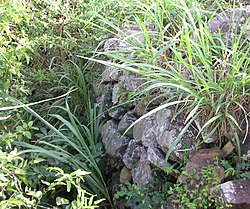Fort Charlotte, Totola
| Fort Charlotte | |
| British Virgin Islands | |
|---|---|
 Part of the remains of the walls of Fort Charlotte | |
| Location | |
| Location: | 18°24’49"N, 64°37’24"W |
| History | |
| Built 1794 | |
| Information | |
| Condition: | ruins |
Fort Charlotte is a ruined fort built on Harrigan's Hill (above Macnamara) on Tortola, among the British Virgin Islands. The fort was named after Charlotte of Mecklenburg-Strelitz, who was the Queen of King George III.
The fort was built by the British Royal Engineers in 1794 at an elevation of approximately 947 feet over Road Town. However, it was constructed on top of an earlier wooden stockade believed to have been originally erected by the privateer Joost van Dyk to act as a lookout post. The fort was not a walled fort in the traditional sense, but only an earthen one. However, its elevation meant that there was absolutely no prospect of receiving cannon fire from incoming ships. The only way in which the Fort could have been taken (it never fell) would have been for troops to climb the hill whilst under heavy musket and cannon fire.
Fort Charlotte formed part of a triangular defensive formation around Road Harbour. On the south west side of the habour lay Fort Burt. On the northwest there was Fort George. In the middle stood Road Town Fort. And towering above both was Fort Charlotte, with the range and guns to fire on any ship entering the harbour without any fear of return fire. Accordingly, any ship seeking to attack the town would have to withstand fire from both Fort Charlotte and either Fort Burt or Fort George, but would have to actually land and climb Harrigan's Hill (with weaponry) to a height of nearly 900 feet before they could actually return fire on the garrison.

Road Town became the Territory's capital instead of much better anchorages at Soper's Hole, Hodge's Creek and Spanish Town on Virgin Gorda (each of which at some point in the Territory's history acted as the centre of administration for the islands) largely because of its instrinsic defensiveness in a highly turbulent era. Tortola had been sacked by Spanish pirates in 1685 and Tortola was actually occupied by pirates for several days in 1686, but was never attacked again subsequent to the construction of Fort Charlotte.
Tortola was never again attacked during the turbulent colonial era, and it is reasonable to surmise that the combination of the relatively low economic value of the Territory, and the relatively formidable defences, simply meant that it was an equally unattractive target for competing colonial powers on the one hand and privateers and pirates on the other.

The fort is now a barely recognisable ruin. All that remains are a few barely standing walls, a cistern and an underground magazine. The area of the Fort is heavily overgrown, and for safety reasons the government has sealed off the cistern to avoid the possibility of tourists falling in. The hike to Fort Charlotte (there is no road) is considerably less arduous since the government cut a road from the top of Macnamara to the ridge, but it is still a good climb, and a machete to clear the bush that frequently overgrows the donkey track leading to the fort is usually a necessity during the wet season.
Like many historical buildings in the British Virgin Islands, Fort Charlotte sits on private land, and there is actually (at present) no public right of way to the Fort. However, also characteristically of the British Virgin Islands, local landowners have to date been reasonably relaxed about the occasional tourists and students hiking across their land to find the remains of the Fort.
The government has evinced an intention to make Fort Charlotte more accessible, but to date no action has been forthcoming.